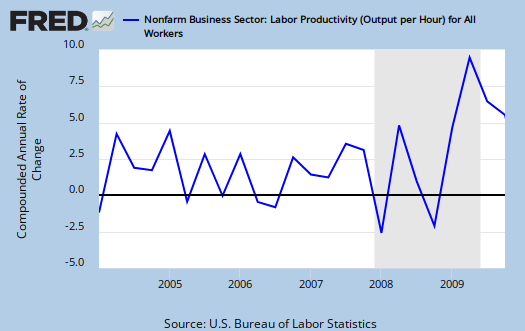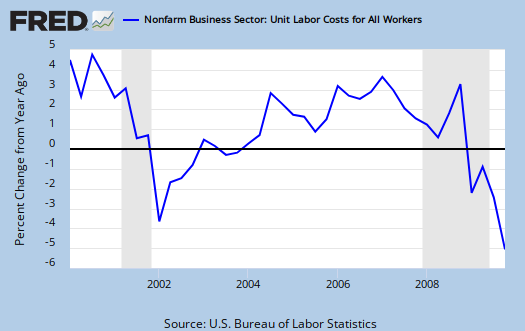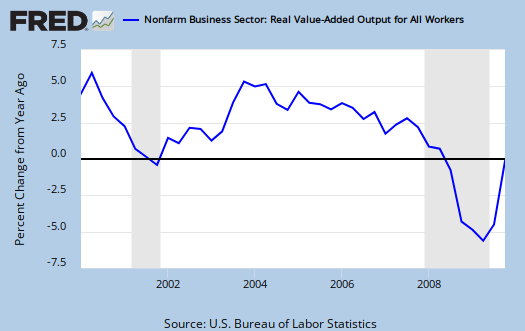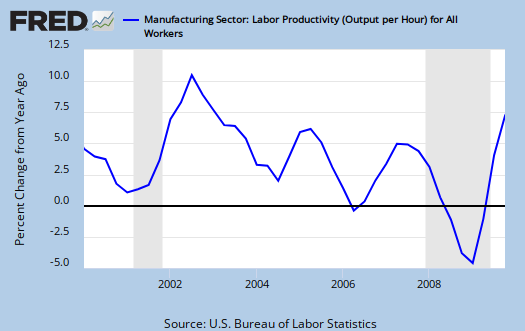Oh woe to the U.S. worker. Labor Productivity soared 6.2% in Q4 2009. We have a 7.2% increase in output and a measly 1.0% increase in hours worked. Hourly compensation increased 1.5%.
For the year labor productivity increased 5.1% and only compares to the great job exodus of 2001/2002.
Compounded against last quarter percent change:

Yearly change:

Below is a output per hours worked graph from 1990 until Q4 2009. Notice the huge productivity spike in 2002.

Below is the unit labor costs, compounded annual rate, percent change. Unit labor costs declined 4.4% for Q4 2009, 2.8% for the year and is the worst since th 3.2% unit labor cost yearly decline ending in Q1 2002.
Late 2001 is when the directive to offshore outsource everything that wasn't nailed down occurred. The 2000 China trade agreement also kicked in. Here is the graph of percent change in comparison to 1 year ago. Again, one sees a similar pattern:

Here is the from previous quarter, annual change rate:

Here is the actual output:

So, we can see the direct effect of the recession in terms of widgets made, yet notice this last quarter, output is more comparable to the 2002 time period.
Hours worked are down 6.4% and output is down 3.6% in 2009. These are both record declines.
How does the DOL calculate labor productivity?
Labor productivity is calculated by dividing an index of real output by an index of the combined hours worked of all persons, including employees, proprietors, and unpaid family workers.
This is all calculated from BSL CES and Current Population survey data and is in part, estimated.
Let's talk about offshore outsourcing, which is never mentioned in soaring productivity figures.
From the BLS:
If a domestic computer manufacturer switches from domestic to foreign suppliers of intermediate inputs such as computer memory chips or call center services, real manufacturing sectoral output is unchanged because the real value of the computer is unchanged. Because U.S. jobs are lost (all other things unchanged), labor productivity will rise. If the U.S. manufacturer switches most of its production to off-shore facilities, labor productivity might rise substantially.
In other words, we have many products that are so called produced in the United States, when there is a host of labor costs that are involved in that output, but are offshore.
Note, the U.S. government refuses to collect citizenship status of all workers inside the U.S., physical location of workers, as well as any raw data on offshore outsourced production by corporations.
This paper by Susan Houseman, 2007, overviews some of the research conclusions as well as her own in trying to ascertain how much of the rise in productivity is due to global labor arbitrage.
Manufacturing is much worse. Productivity increased 7.8% in Q4 2009, yet unit labor costs dropped 7.4%. Output for manufacturing increased 6.1% yet hours worked dropped 1.6%.


Subject Meta:
Forum Categories:
| Attachment | Size |
|---|---|
| 140.79 KB |

Interesting
That's hilarious (in a dark humor way) how U.S. labor productivity "increases" as jobs are sent elsewhere. It would be interesting to see productivity measured in terms of value added. I bet it would be a downward slope.
http://jims-blog.com